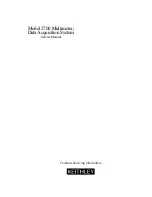
Using a
Baseline Reference
Abaseline
reference
allows
you to
compare components
directly.
For
example,
you
can compare
resistors
in
a
set
by
measuring
one
resistor
as
the
baseline
and
then measuring
how closely
the
remaining
resistors match
the
baseline.
1.
Select
the
function (not °C/°F, dBm,
9),
DF, LOGIC,
or
hg).
2.
Press
RANGE
to
select
a
range
3.
Connect
the
test
leads to
the
component whose measurement
you
want to
use as
a
baseline.
4.
When you
see
the
reading,
press
RELA.
Rel
A
appears and
the
meter
sets
to manual range
5. Take a
measurement
for
another component. Rather than
the
actual
measurement
value, the
meter
will
display
the
component's
variation
from
the
baseline
(0.20.
0.01,-0.13,-0.02,
etc.).
If
the
measured
value
is
lower
than
the
baseline,
the
meter
will
show
a
negative
relative value.
A
reading of
0.00 indicates
an
exact match.
»
To
stop
relative
measurement, press RELA
again
or
set
the
function
dial
to
another
setting.
Note:
+
Forthe most accurate
reading,
the temperature
should
be between 65°F and
83°F (18°C
and
28°C),
with
a maximum
of
75% relative humidity.
Relative
and
baseline
measurements
MUST
always
be
in
the manual
ranging
mode.
+
When measuring
voltages
in
zero
offset or
baseline mode,
the
noise
of the
environment
you
are measuring
in
could interfere
with
measurements.
Measuring
Temperature
{N
warning:
+
Donotuse
the thermocouple
to
measure objects
when
the
voltage
is
above
30VRMS
and 42.4Vpeak or
60V
DC,
=
Measuring high
temperatures
with
the
included
probe
can
cause personal
injury
(including burns)
or damage
to
the
thermocouple’s probe.
Set
the
function
dial
to °C/°F.
2. Plug
the
thermocouples
black lead into ~COM
(common), then
plug
its
red
lead into
+V.mA.Q.
3.
Press
SELECT
to
select
Celsius
(°C)
or Fahrenheit
(°F).
Goji
x
ed
=
ae
ET
Beoo8
<O
20









































